Entry into the System: Arrest
- The instance of a crime is reported by the child with a broken leg (ABC15 Arizona, 2011).
- Travis Darrah is identified.
- He is suspected of child abuse.
- The police determine the damage was done by Travis.
Arrest is applied only in a limited number of cases when there is reason to assume that the incident is criminal in nature. Meanwhile, in practice, situations are not uncommon when restricting individual freedom is dictated by tasks of a higher level – the need to maintain public order. Provided that such detention is short-term and ends here on the street, it is not considered an arrest. If it follows from the circumstances of the incident that a crime has been committed and the person is not immediately released on the spot, then such a temporary restriction of freedom is considered to be an arrest.

Prosecution and Pretrial Services: Charges Filed
- The law enforcement agency gathers information about the prosecutor Travis Darrah.
- The agency prepares the information for the presentation.
- Formal charges against Travis Darrah (“Criminal justice system flowchart,” n.d.).
While the arrest was the culmination of the entry into the system, the process of filing charges is the beginning of prosecution and pretrial services. Travis Darrah cannot be kept under the arrest if no charges are filed. Therefore, the law enforcement agency needs to file charges and prepare the relevant information on Travis Darrah in order to present it to the court. The fact that the child ran from his house to the police station with a broken leg provides a sufficient basis to file the charges against the suspect. The prosecutor can also drop the charges by declaring nolle prosequi, but the case does not consider this option (“Criminal justice system flowchart,” n.d.).
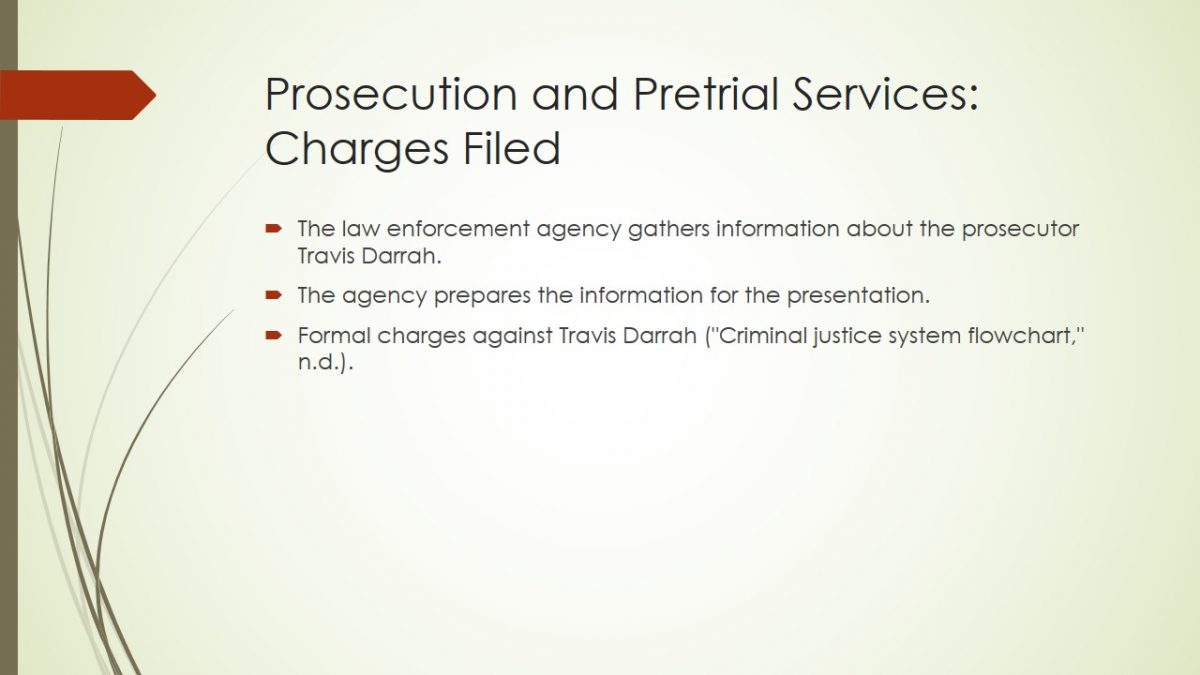
Prosecution and Pretrial Services: Initial Appearance
- Travis Darrah is informed on charges.
- The defense counsel can be assigned.
- Information is presented.
- Reasons for the arrest.
- Probable cause determination – Travis Darrah being involved in child abuse.
During the initial appearance, the judge or magistrate acquires necessary information regarding the defendant. This step occurs during 48 hours after the arrest took place in order to prevent longitudinal waiting due to pending of the procedures (“Criminal justice system flowchart,” n.d.). The judge informs the defendant on the charges by officially announcing the statements. It is important to note that the defendant has the right for defense counsel in the form of attorney or public defender. The law enforcement agency needs to present the basis on which the defendant was arrested. After the latter step, the judge makes the probable cause determination, where Travis Darrah was involved in child abuse.
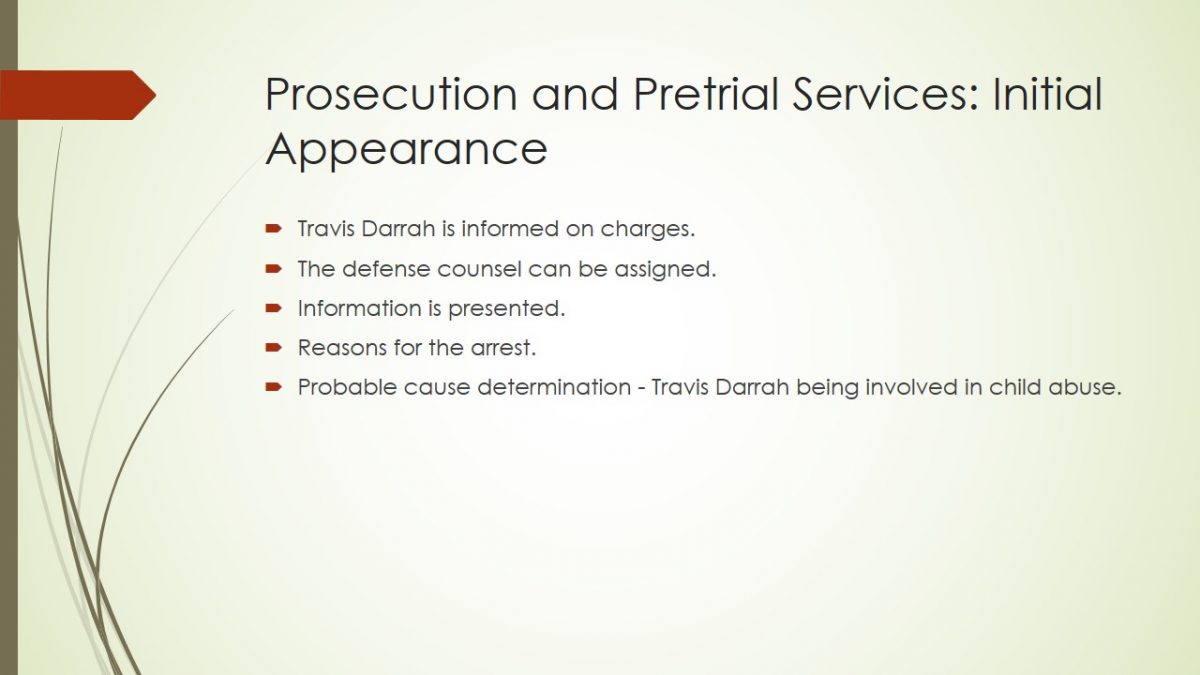
Prosecution and Pretrial Services: Preliminary Hearing
- The preliminary hearing is designed to determine if there is a probable cause.
- It does not seek to establish whether or not the defendant is guilty or innocent.
- The judge proceeds with bail and detention hearing.
The participation of the parties is a guarantee of the adversarial nature of the fact that the prosecutor and the defense attorney must take part in the preliminary hearing. An exception can only be the situation when the accused refused to participate in the defense counsel, and in this case, the participation of the accused must be mandatory. When deciding on the composition of the participants at the preliminary hearing, the question arises about the status of the representative of the prosecution acting on behalf of the state. Considering the burden of proof, the legislator speaks of the prosecutor as a participant in the preliminary hearing.
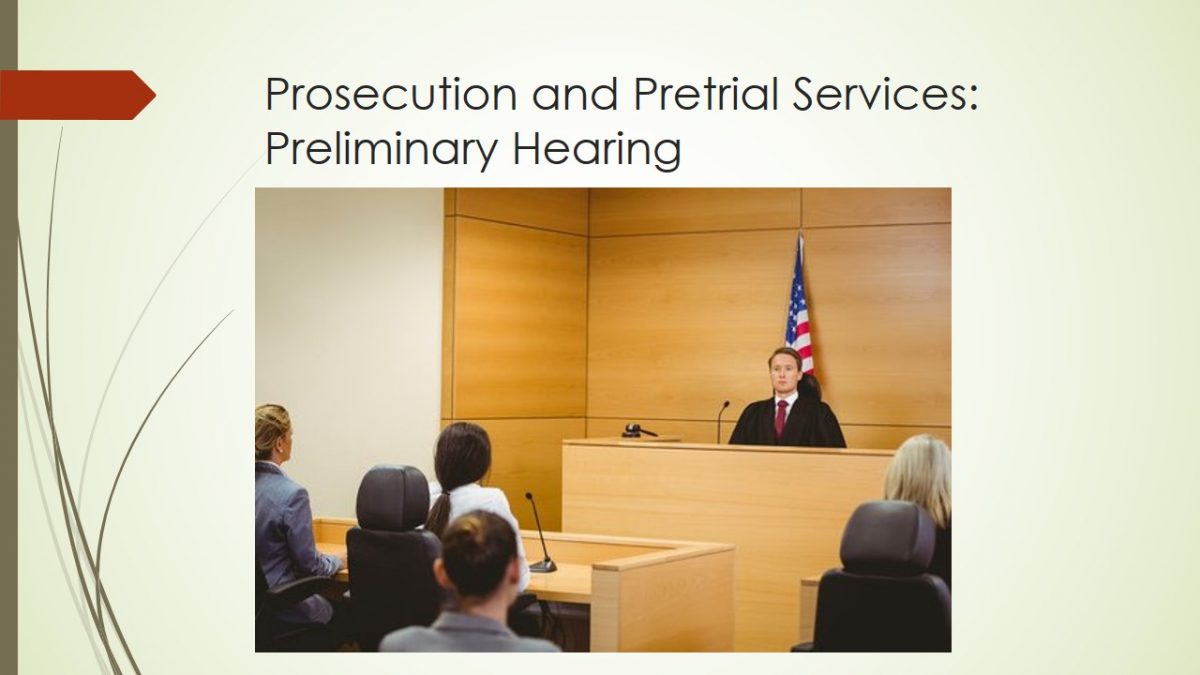
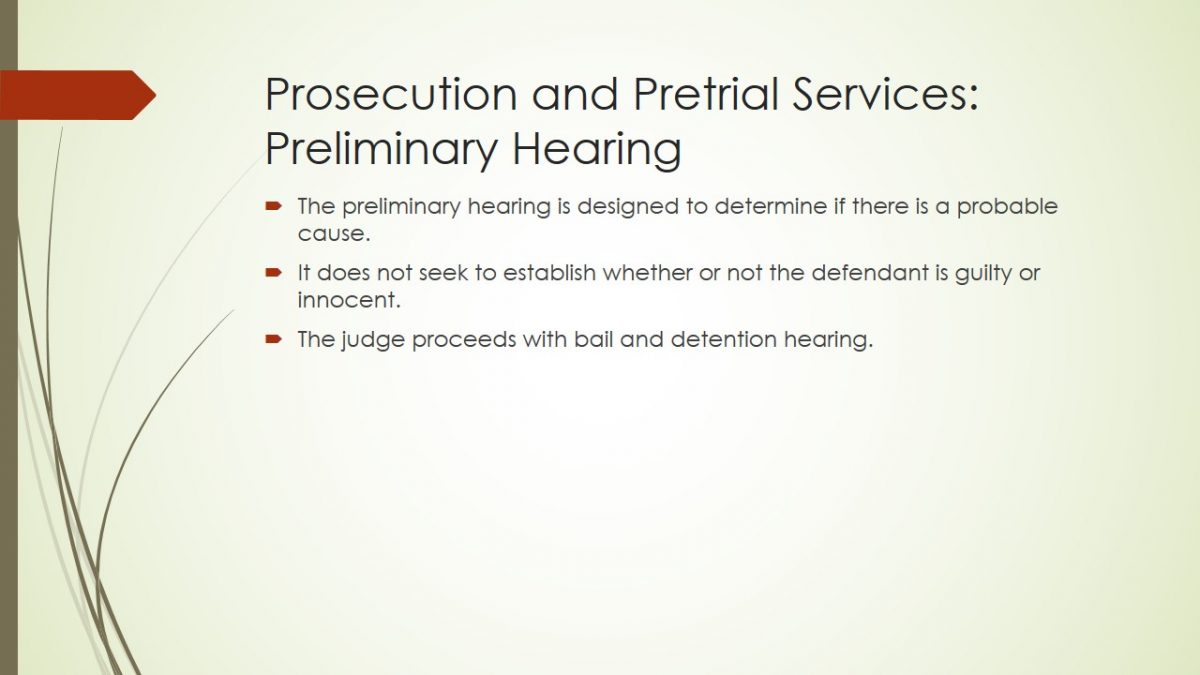
Prosecution and Pretrial Services: Bail or Detention Hearing
- A preliminary hearing can be followed by Bail and Detention Hearing.
- The judge – either bail or detain.
- Travis Darrah – detained without any opportunity for bail.
- The defendant – detained, even if the process is pending.
Bail and detention hearing cannot be held at the initiative of the court. The actions of the court are completely dependent on the choice of the form of legal proceedings by the accused. If the accused refuses the jury at the stage of the preliminary investigation, the judge appoints the hearing in a general manner, without holding a preliminary hearing. The exception cases in which the accused refused the jury, but there is another reason for the appointment of a preliminary hearing. During the preliminary hearing, the accused may change his position and file a motion for trial by jury.
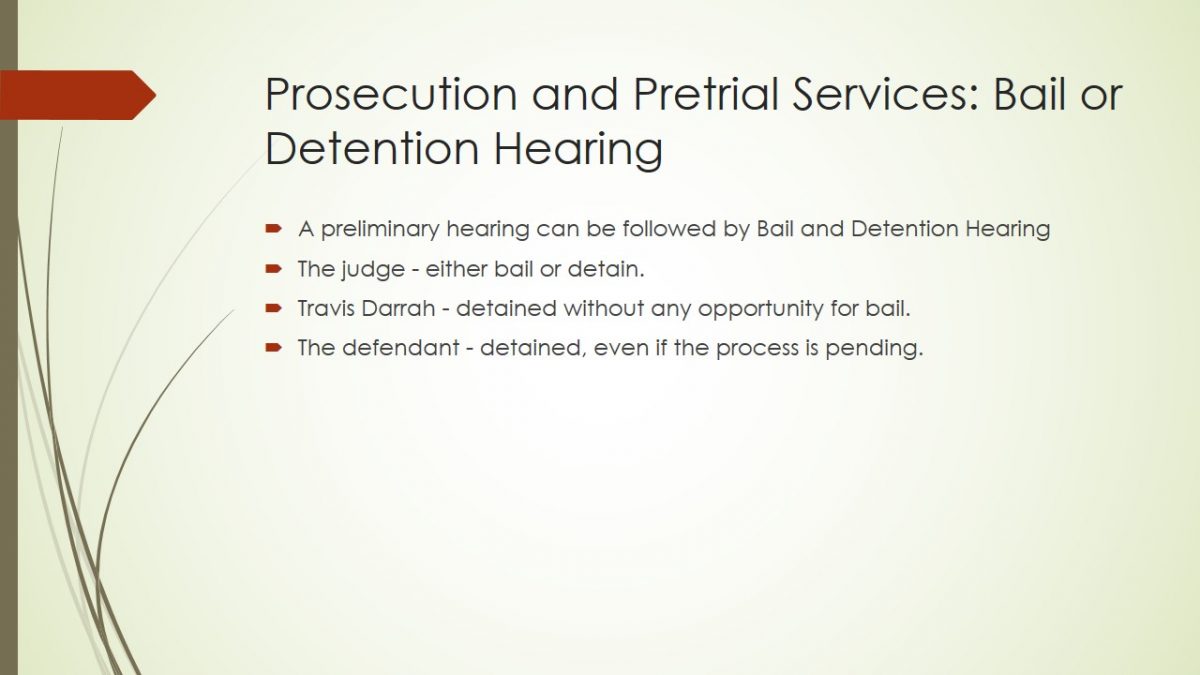
Prosecution and Pretrial Services: Information
- The case is bound to Grand Jury.
- Grand Jury is assembled for Travis Darrah.
- A grand jury is convened.
The grand jury is a panel of jurors that examines the validity of a criminal offense put forward by a public prosecutor and decides on the need to bring an accused to trial. The functioning of these collegiums created by the courts of the first instance is characteristic of common law countries, where preliminary investigation and inquiry are not carried out due to the lack of such procedures in criminal procedure law. Verification of the validity of the charge is entrusted to citizens who are members of the grand jury. During the consideration of cases as part of a grand jury, citizens perform some functions of the preliminary investigation bodies.
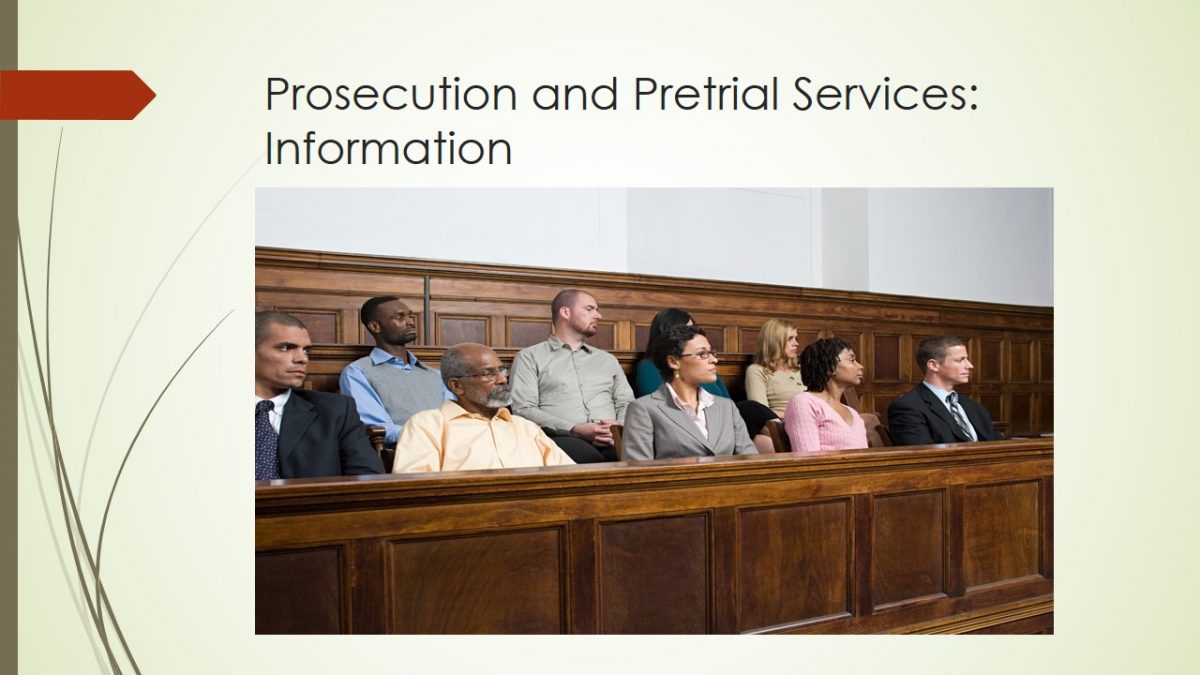
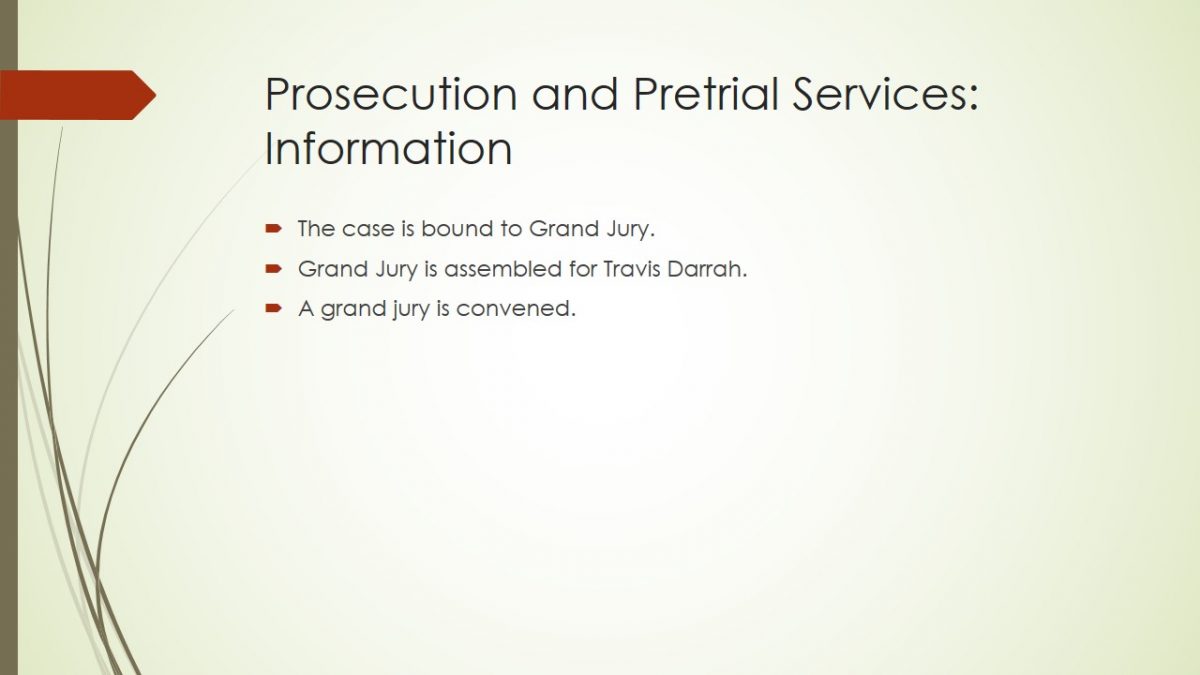
Adjudication: Arraignment
- In the initial form of arrangement, the indictment is read to the defendant.
- Travis Darrah is called to plead.
- A copy of the indictment is given.
- In post-indictment arraignment – Travis is permitted to enter a plea.
Travis Darrah is called to plead, and he is given a copy of the indictment. In the initial form of arrangement, the indictment is read to the defendant. In post-indictment form of arraignment, Travis is permitted to enter plea. The stage requires extensive process of analysis where the judge regulates and sets the interaction between defendant and plaintiff in order to yield the most plausible outcome. Plead is a central functional optional consideration that can be granted to Travis Darrah in order to establish some form of arrangement. Although there are two forms of arraignments, one should understand that the case involves the post-indictment arraignment.
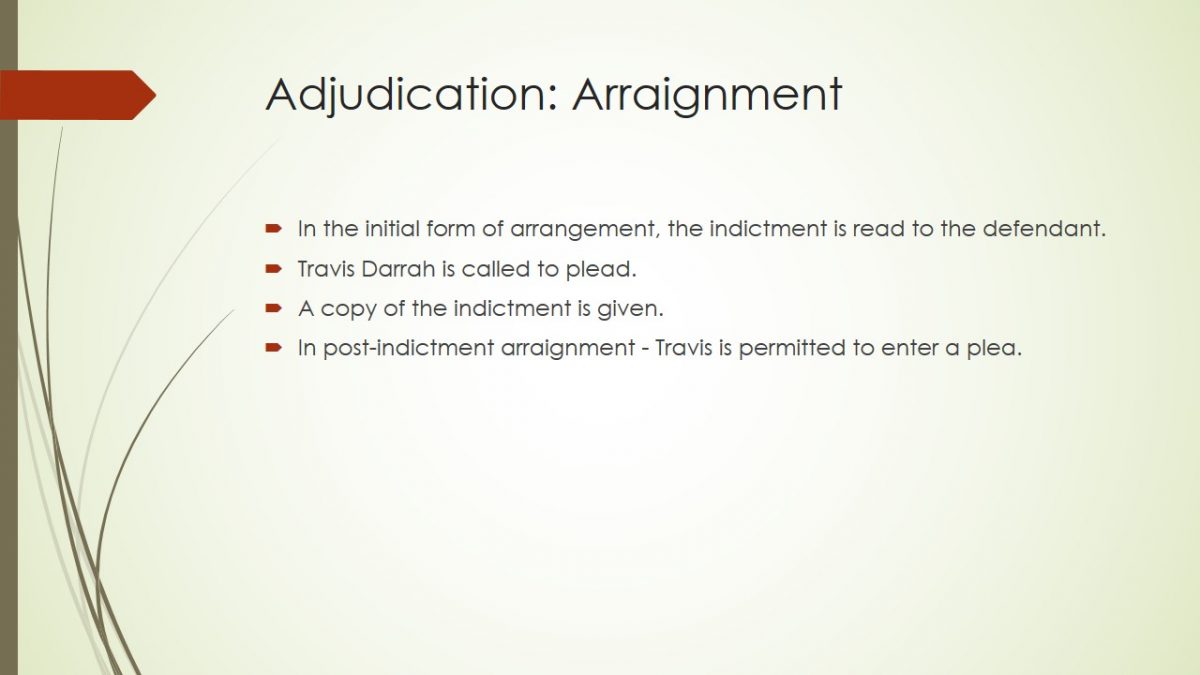
Adjudication: Trial
- Travis Darrah – trial by jury is guaranteed.
- Reason – the seriousness of the crime.
- Both sides present evidence.
- The accused – bench trial with the judge.
- Acquittal or conviction.
- In the case of Travis Darrah, he is convicted of child abuse.
In the system of each democratic state, a special role is played by the judiciary. The main reason for this is the function assigned to the court – the administration of justice. No other state body can perform this function, which, in turn, speaks of the independence of the court, and ensuring democratic principles, guaranteeing the rights and freedoms of citizens. Judicial power can be characterized as a system of special state bodies vested with constitutional legal powers to resolve issues within their competence arising in the application of the law and their implementation by the courts through constitutional proceedings.
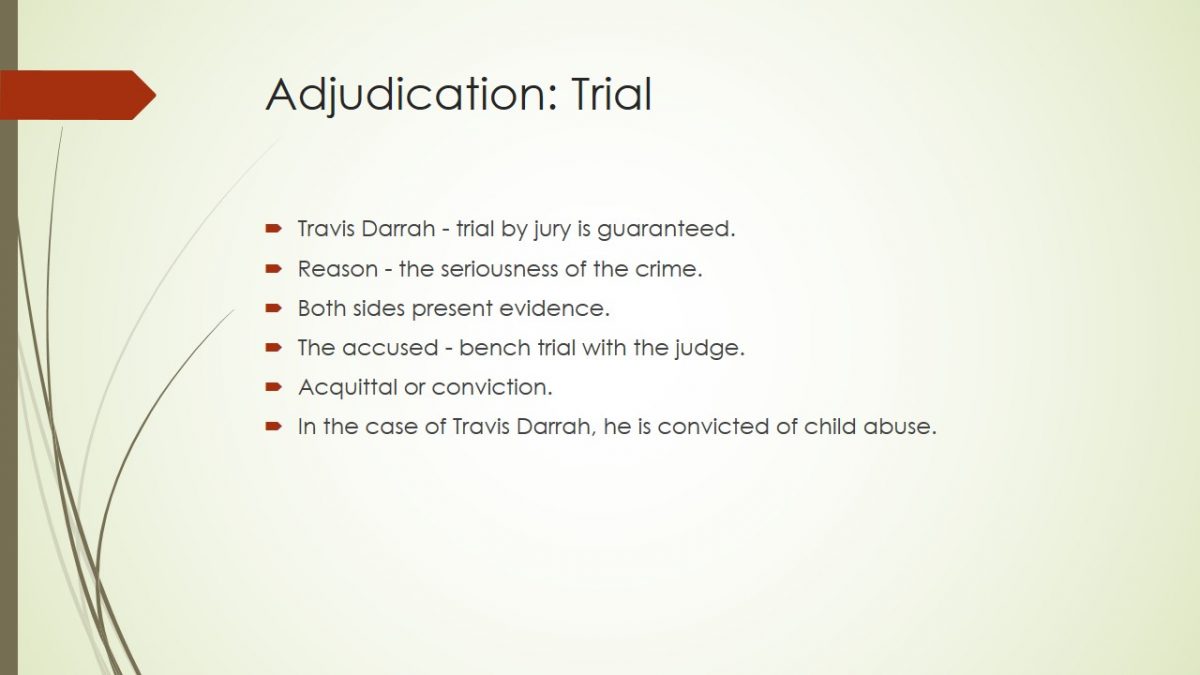
Adjudication: Conviction
- Conviction is a recognition of the prosecutor’s evidence.
- Travis Darrah is convicted of child abuse.
- Conviction – the basis for sentencing.
Conviction is associated with the implementation of certain elements of coercion, but this coercion is not associated with punishment, it is primarily corrective in nature. Conviction from these positions is often seen as a non-punitive measure of a criminal law nature. The measure is assigned instead of it and taking into account the achievement of its particular goals, and therefore cannot pursue what other goals. At the same time, it must be borne in mind that this criminal-law measure is aimed at achieving the goals of punishment, not because it is a separate type, but because conviction is possible only if the court considers that the goals of the appointed his punishments can be achieved without its real execution.
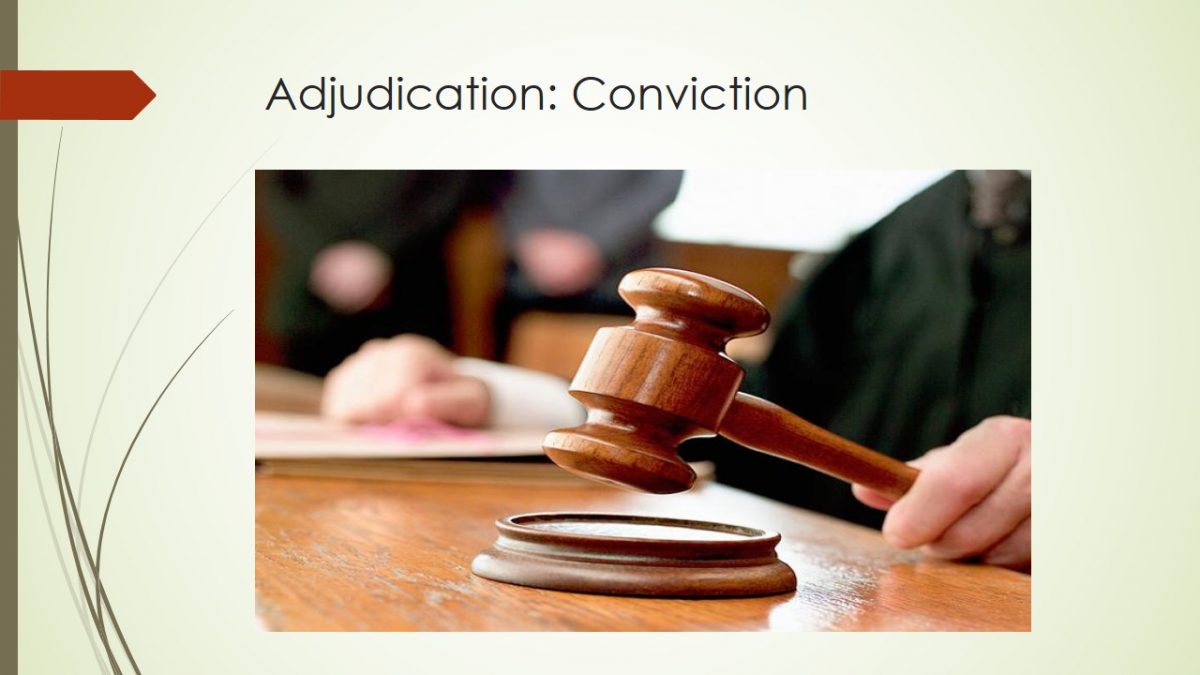
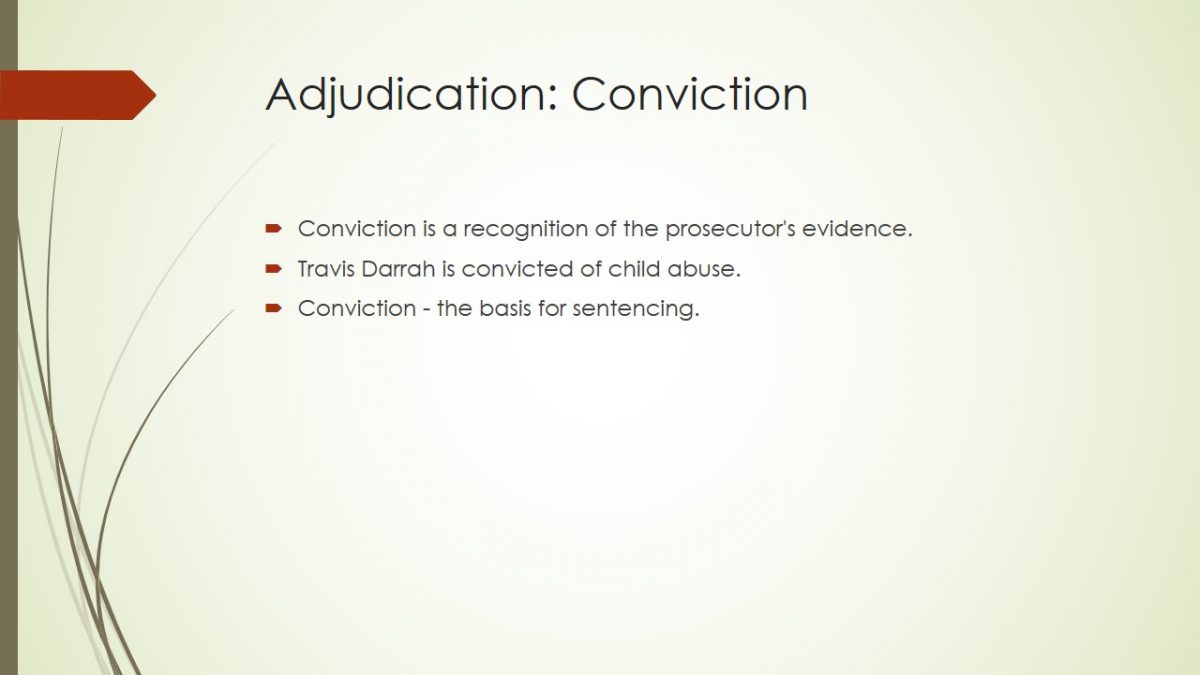
Sentencing and Sanctions: Sentencing
- The probable sentence – prison term up to five years.
- Reason – average sentence for child abusers (Darling et al., 2018).
- Serious cases – longer prison term (“Child abuse penalties and sentencing,” 2018).
- Institutionalization.
- Parole during the correction (“Criminal justice system flowchart,” n.d.).
Sentence is the most important act of justice, and it is an act of the judiciary branch of legal power. In addition, the sentence implements the main function of the court to administer justice. By its nature, it is an act of application of the law, and the legal significance of the verdict is that only in the verdict does the court have the right to convict a person of a crime and to sentence Travis Darrah. The sentence will most likely result in a 5-year prison term due to high rates of child abuse cases resulting in the latter (Darling et al., 2018).

Sentencing and Sanctions: Alternative Sentencing
- History of child abuse and neglect – capital punishment (Holleran et al., 2016).
- Arizona State allows capital punishment.
- Juror decisions – severe sentencing (Holleran et al., 2016).
- Alternative sentencing – ethical repercussions.
The attitude towards the death penalty has always been and will be ambiguous. Currently, a significant number of countries have refused this type of punishment, due to the general tendency of the world community to recognize human life as the highest value, to the conclusion that even the state does not have the right to take a person’s life. At the same time, there remained countries where the death penalty remains. The rule of law must be stable in order to ensure the correct sentencing. To ensure the stability of the sentence, a special mechanism must exist in the criminal procedure legislation.

Corrections: Out of System
- After serving the prison term, Travis Darrah will be out of the system.
- The weakest link – pretrial services.
- Reason – the lack of in-depth analysis of the case and heavy reliance on prosecutors.
- The strongest link – arraignment.
- Reason – proceed with the plea.
This contradiction significantly complicates the determination of the procedural form of the decision to be released from punishment in connection with a change in the situation. In contrast to the previously existing type of exemption from criminal responsibility of the same name, it still does not have a clearly defined procedural form of application in the law, which negatively affects judicial practice. The results of exemption from punishment in connection with a change in the situation indicate that the execution of the relevant court decision is carried out by a guilty verdict with the sentence and subsequent release from serving it.
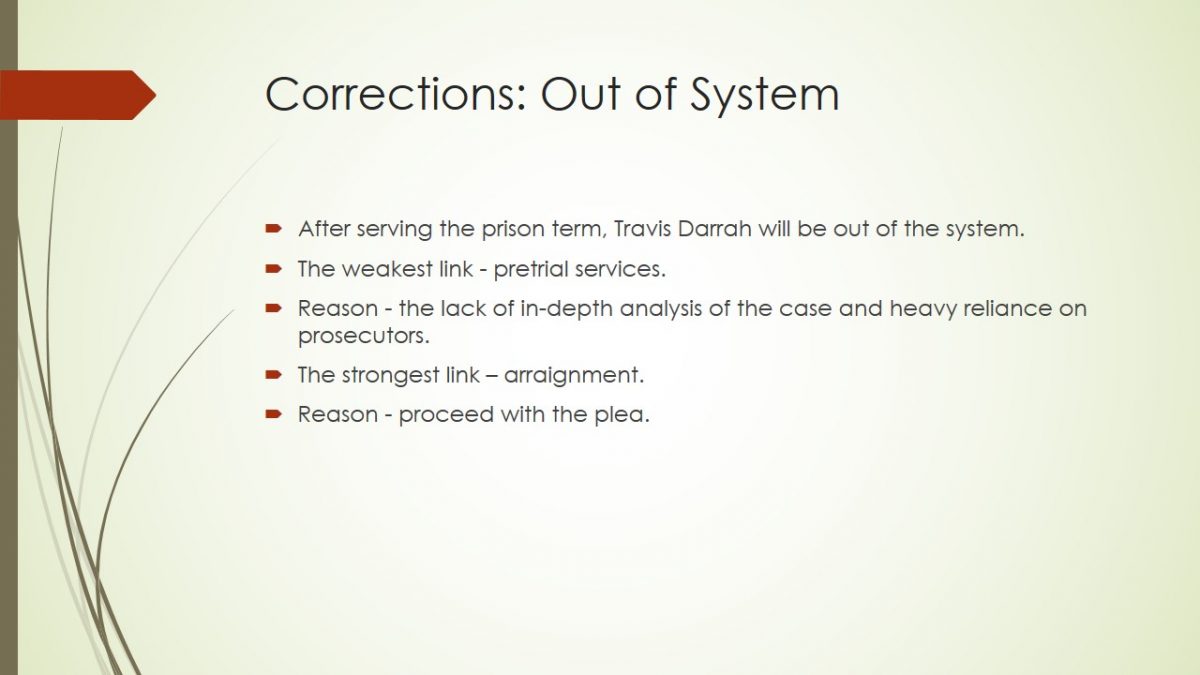
References
- ABC15 Arizona. (2011). Chandler couple arrested for child abuse [Video]. YouTube. Web.
- Child abuse penalties and sentencing. (2018). Web.
- Criminal justice system flowchart. (n.d.). Web.
- Darling, A. J., Hackett, S., & Jamie, K. (2018). Female sex offenders who abuse children whilst working in organisational contexts: Offending, conviction and sentencing. Journal of Sexual Aggression, 24(2), 196-214.
- Holleran, L. L. B., Vaughan, T. J., & Vandiver, D. M. (2016). Juror decision‐making in death penalty sentencing when presented with defendant’s history of child abuse or neglect. Behavioral Sciences & The Law, 34(6), 742-766.